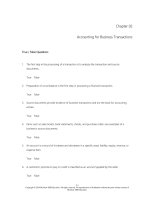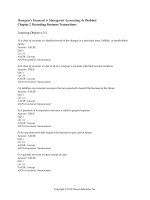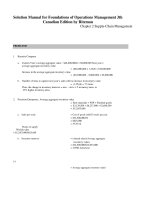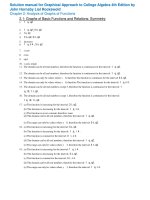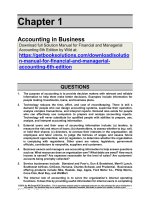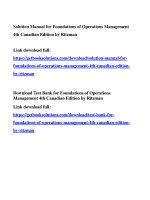Solution manual for horngrens financial and managerial accounting 6th edition by miller nobles
Bạn đang xem bản rút gọn của tài liệu. Xem và tải ngay bản đầy đủ của tài liệu tại đây (2.12 MB, 78 trang )
Solution Manual for Horngrens Financial and Managerial Accounting 6th Edition by Miller Nobles
Full file at />
Chapter 1
Accounting and the Business Environment
Review Questions
1. What is accounting?
Accounting is the information system that measures business activities, processes the information
into reports, and communicates the results to decision makers. Accounting is the language of
business.
2. Briefly describe the two major fields of accounting.
Financial accounting provides information for external decision makers, such as outside investors,
lenders, customers, and the federal government. Managerial accounting focuses on information for
internal decision makers, such as the company’s managers and employees.
3. Describe the various types of individuals who use accounting information and how they use that
information to make important decisions.
Individuals use accounting information to help them manage their money, evaluate a new job, and
better decide whether they can afford to make a new purchase. Business owners use accounting
information to set goals, measure progress toward those goals, and make adjustments when needed.
Investors use accounting information to help them decide whether or not a company is a good
investment and once they have invested, they use a company’s financial statements to analyze how
their investment is performing. Creditors use accounting information to decide whether to lend
money to a business and to evaluate a company’s ability to make the loan payments. Taxing
authorities use accounting information to calculate the amount of income tax that a company has to
pay.
4. What are two certifications available for accountants? Briefly explain each certification.
Certified Public Accountants (CPAs) are licensed professional accountants who serve the general
public. They work for public accounting firms, businesses, government, or educational institutions.
To be certified they must meet educational and/or experience requirements and pass an exam.
Certified Management Accountants (CMAs) specialize in accounting and financial management
knowledge. They work for a single company.
5. What is the role of the Financial Accounting Standards Board (FASB)?
The FASB oversees the creation and governance of accounting standards. They work with
governmental regulatory agencies, congressionally created groups, and private groups.
6. Explain the purpose of Generally Accepted Accounting Principles (GAAP), including the
organization currently responsible for the creation and governance of these standards.
© 2018 Pearson Education, Inc.
Full file at />
1-1
Solution Manual for Horngrens Financial and Managerial Accounting 6th Edition by Miller Nobles
Full file at />The guidelines for accounting information are called GAAP. It is the main U.S. accounting rule
book and is currently created and governed by the FASB. Investors and lenders must have
information that is relevant and has faithful representation in order to make decisions and GAAP
provides the framework for this financial reporting.
7. Describe the similarities and differences among the four different types of business entities discussed
in the chapter.
A sole proprietorship has a single owner, terminates upon the owner’s death or choice, the owner has
personal liability for the business’s debts, and it is not a separate tax entity. A partnership has two or
more owners, terminates at partner’s choice or death, the partners have personal liability, and it is
not a separate tax entity. A corporation is a separate legal entity, has one or more owners, has
indefinite life, the stockholders are not personally liable for the business’s debts, and it is a separate
tax entity. A limited-liability company has one or more members and each is only liable for his or
her own actions, has an indefinite life, and is not a separate tax entity.
8. A business purchases an acre of land for $5,000. The current market value is $5,550, and the land
was assessed for property tax purposes at $5,250. What value should the land be recorded at, and
which accounting principle supports your answer?
The land should be recorded at $5,000. The cost principle states that assets should be recorded at
their historical cost.
9. What does the going concern assumption mean for a business?
The going concern assumption assumes that the entity will remain in business for the foreseeable
future and long enough to use existing resources for their intended purpose.
10. Which concept states that accounting information should be complete, neutral, and free from
material error?
The faithful representation concept states that accounting information should be complete, neutral,
and free from material error.
11. Financial statements in the United States are reported in U.S. dollars. What assumption supports this
statement?
The monetary unit assumption states that items on the financial statements should be measured in
terms of a monetary unit.
12. Explain the role of the International Accounting Standards Board (IASB) in relation to International
Financial Reporting Standards (IFRS).
The IASB is the organization that develops and creates IFRS which are a set of global accounting
standards that would be used around the world.
© 2018 Pearson Education, Inc.
Full file at />
1-2
Solution Manual for Horngrens Financial and Managerial Accounting 6th Edition by Miller Nobles
Full file at />13. What is the accounting equation? Briefly explain each of the three parts.
Assets = Liabilities + Equity. Assets are economic resources that are expected to benefit the
business in the future. They are things of value that a business owns or has control of. Liabilities
are debts that are owed to creditors. They are one source of claims against assets. Equity is the
other source of claims against assets. Equity is the stockholders’ claims against assets and is the
amount of assets that is left over after the company has paid its liabilities. It represents the net worth
of the corporation.
14. How does retained earnings increase? What are the two ways that retained earnings decreases?
Retained earnings increases with revenues. Retained earnings decreases with expenses and
dividends.
15. How is net income calculated? Define revenues and expenses.
Revenues – Expenses = Net Income. Revenues are earnings resulting from delivering goods or
services to customers. Expenses are the cost of selling goods or service.
16. What are the steps used when analyzing a business transaction?
Step 1: Identify the accounts and the account type. Step 2: Decide if each account increases or
decreases. Step 3: Determine if the accounting equation is in balance.
17. List the four financial statements. Briefly describe each statement.
Income Statement – Shows the difference between an entity’s revenues and expenses and reports the
net income or net loss for a specific period.
Statement of Retained Earnings – Shows the changes in retained earnings for a specific period
including net income (loss) and dividends.
Balance Sheet – Shows the assets, liabilities, and stockholders’ equity of the business as of a specific
date.
Statement of Cash Flows – Shows a business’s cash receipts and cash payments for a specific period.
18. What is the calculation for ROA? Explain what ROA measures.
Return on Assets = Net income / Average total assets. ROA measures how profitably a company
uses its assets.
© 2018 Pearson Education, Inc.
Full file at />
1-3
Solution Manual for Horngrens Financial and Managerial Accounting 6th Edition by Miller Nobles
Full file at />
Short Exercises
S1-1 Identifying users of accounting information
Learning Objective 1
For each user of accounting information, identify if the user would use financial accounting or
managerial accounting
a. investor
e. controller
b. banker
f. stockholder
c. IRS
g. human resources director
d. manager of the business
h. creditor
SOLUTION
a.
b.
c.
d.
FA
FA
FA
MA
e. MA
f. FA
g. MA
h. FA
S1-2 Determining organizations that govern accounting
Learning Objective 2
Suppose you are starting a business, Wholly Shirts, to imprint logos on T-shirts. In organizing the
business and setting up its accounting records, you take your information to a CPA to prepare financial
statements for the bank. Name the organization that governs the majority of the guidelines that the CPA
will use to prepare financial statements for Wholly Shirts. What are those guidelines called?
SOLUTION
The Financial Accounting Standards Board governs the majority of guidelines, called Generally Accepted
Accounting Principles (GAAP), that the CPA will use to prepare financial statements for Wholly Shirts.
© 2018 Pearson Education, Inc.
Full file at />
1-4
Solution Manual for Horngrens Financial and Managerial Accounting 6th Edition by Miller Nobles
Full file at />S1-3 Identifying types of business organizations
Learning Objective 2
Chloe Michaels plans on opening Chloe Michaels Floral Designs. She is considering the various types of
business organizations and wishes to organize her business with unlimited life and wants owners of the
business to not be held personally liable for the business’s debts. Additionally, Chloe wants the business
to be a separate taxable entity. Which type of business organization will meet Chloe’s needs best?
SOLUTION
Chloe’s needs will best be met by organizing a corporation since a corporation has an unlimited life and
is a separate tax entity. In addition, the owners (stockholders) have limited liability. Chloe could also
consider a limited liability company (LLC) as an option. A LLC meets two of the three criteria. It has an
unlimited life and limited liability for the owner. However, a LLC is not a separate tax entity.
S1-4 Identifying types of business organizations
Learning Objective 2
You would like to start a cellular telephone equipment service business. You are considering organizing
the business as a sole proprietorship. Identify the advantages and disadvantages of owning a sole
proprietorship.
SOLUTION
Advantages:
1. Easy to organize.
2. Unification of ownership and management.
3. Less government regulation.
4. Owner has more control over business.
Disadvantages:
1. The owner pays taxes on the entity’s earnings since it is not a separate tax entity.
2. No continuous life or transferability of ownership.
3. Unlimited liability of owner for business’s debts.
S1-5 Applying accounting assumptions and principles
Learning Objective 2
Michael McNamee is the proprietor of a property management company, Apartment Exchange, near the
campus of Pensacola State College. The business has cash of $8,000 and furniture that cost $9,000 and
has a market value of $13,000. The business debts include accounts payable of $6,000. Michael’s
personal home is valued at $400,000, and his personal bank account has a balance of $1,200. Consider
the accounting principles and assumptions discussed in the chapter, and identify the principle or
assumption that best matches the situation:
© 2018 Pearson Education, Inc.
Full file at />
1-5
Solution Manual for Horngrens Financial and Managerial Accounting 6th Edition by Miller Nobles
Full file at />a. Michael’s personal assets are not recorded on the Apartment Exchange’s balance sheet.
b. The Apartment Exchange records furniture at its cost of $9,000, not its market value of $13,000.
c. The Apartment Exchange reports its financial statements in U.S. dollars.
d. Michael expects the Apartment Exchange to remain in operation for the foreseeable future.
SOLUTION
a. The economic entity assumption
b. The cost principle.
c. The monetary unit assumption.
d. The going concern assumption.
S1-6 Using the accounting equation
Learning Objective 3
Thompson Handyman Services has total assets for the year of $18,400 and total liabilities of $9,050.
Requirements
1. Use the accounting equation to solve for equity.
2. If next year assets increased by $4,300 and equity decreased by $3,850, what would be the amount
of total liabilities for Thompson Handyman Services?
SOLUTION
Requirement 1
Thompson Handyman Services has equity of $9,350.
Assets
$18,400
$18,400
=
=
=
Liabilities
$9,050
$9,050
+
+
+
Equity
?
$9,350
+
+
+
Equity
$9,350 – $3,850
$5,500
Requirement 2
Thompson Handyman Services has liabilities of $17,200.
Assets
$18,400 + $4,300
$22,700
=
=
=
Liabilities
?
$17,200
© 2018 Pearson Education, Inc.
Full file at />
1-6
Solution Manual for Horngrens Financial and Managerial Accounting 6th Edition by Miller Nobles
Full file at />S1-7 Using the accounting equation
Learning Objective 3
Roland’s Overhead Doors reports the following financial information:
Assets
$ 45,800
Liabilities
17,220
Common Stock
27,460
Dividends
6,500
Revenues
8,850
Expenses
?
Requirements
1. Use the accounting equation to solve for the missing information.
2. Did Roland’s Overhead Doors report net income or net loss?
SOLUTION
Requirement 1
ASSETS = LIABILITIES +
$45,800
$45,800
=
=
$17,220
$17,220
EQUITY
Contributed
Capital
Common
+
Stock
+
$27,460
+
$27,460
+
Retained Earnings
– Dividends + Revenues – Expenses
–
–
$6,500
$6,500
+
+
$8,850
$8,850
–
–
?
$1,230
Requirement 2
Roland’s Overhead Doors reported net income of $7,620. Net Income = Revenues ($8,850) – Expenses
($1,230)
S1-8 Identifying accounts
Learning Objective 3
Consider the following accounts:
a. Accounts Payable
b. Cash
c. Common Stock
d. Accounts Receivable
© 2018 Pearson Education, Inc.
Full file at />
1-7
Solution Manual for Horngrens Financial and Managerial Accounting 6th Edition by Miller Nobles
Full file at />e. Rent Expense
f. Service Revenue
g. Office Supplies
h. Dividends
i. Land
j. Salaries Expense
Identify each account as Asset, Liability, or Equity.
SOLUTION
a. L
b. A
c. E
d. A
e. E
f. E
g. A
h. E
i. A
j. E
S1-9 Using the accounting equation to analyze transactions
Learning Objective 4
Tiny Town Kennel earns service revenue by caring for the pets of customers. Tiny Town Kennel is
organized as a corporation. During the past month, Tiny Town Kennel has the following transactions:
a. Received $520 cash for service revenue earned.
b. Paid $325 cash for salaries expense.
c. Received a $1,000 contribution in exchange for common stock.
d. Earned $640 for service revenue, but the customer has not paid Tiny Town Kennel yet.
e. Received utility bill of $85, which will be paid next month.
f. Cash dividends of $100 were paid to stockholders.
Indicate the effects of the business transactions on the accounting equation for Tiny Town Kennel.
Transaction (a) is answered as a guide.
a. Increase asset (Cash); Increase equity (Service Revenue)
SOLUTION
a.
b.
c.
d.
e.
f.
Increase asset (Cash); Increase equity (Service Revenue)
Decrease asset (Cash); Decrease equity (Salaries Expense)
Increase asset (Cash); Increase Equity (Common Stock)
Increase asset (Accounts Receivable); Increase equity (Service Revenue)
Increase liability (Accounts Payable); Decrease equity (Utility Expense)
Decrease asset (Cash); Decrease equity (Dividends)
© 2018 Pearson Education, Inc.
Full file at />
1-8
Solution Manual for Horngrens Financial and Managerial Accounting 6th Edition by Miller Nobles
Full file at />S1-10 Using the accounting equation to analyze transactions
Learning Objective 4
Elaine’s Inflatables earns service revenue by providing party planning services and inflatable
playscapes. Elaine’s Inflatables is organized as a corporation. During the past month, Elaine’s
Inflatables had the following transactions:
a. Received contributions of $10,000 in exchange for common stock.
b. Purchased equipment for $5,000 on account.
c. Paid $400 for office supplies.
d. Earned and received $2,500 cash for service revenue.
e. Paid $400 for wages to employees.
f. Cash dividends of $1,000 were paid to stockholders.
g. Earned $1,000 for services provided. Customer has not yet paid.
h. Paid $1,000 for rent.
i. Received a bill for $250 for the monthly utilities. The bill has not yet been paid.
Indicate the effects of the business transactions on the accounting equation for Elaine’s Inflatables.
Transaction (a) is answered as a guide.
a. Increase asset (Cash); Increase equity (Common Stock)
SOLUTION
a.
b.
c.
d.
e.
f.
g.
h.
i.
Increase asset (Cash); Increase equity (Common Stock)
Increase asset (Equipment); Increase liability (Accounts Payable)
Increase asset (Office Supplies); Decrease asset (Cash)
Increase asset (Cash); Increase equity (Service Revenue)
Decrease asset (Cash); Decrease equity (Wages Expense)
Decrease asset (Cash); Decrease equity (Dividends)
Increase asset (Accounts Receivable); Increase equity (Service Revenue)
Decrease asset (Cash); Decrease equity (Rent Expense)
Increase liability (Accounts Payable); Decrease equity (Utilities Expense)
S1-11 Identifying accounts on the financial statements
Learning Objective 5
Consider the following accounts:
a. Accounts Payable
b. Cash
c. Common Stock
d. Accounts Receivable
© 2018 Pearson Education, Inc.
Full file at />
1-9
Solution Manual for Horngrens Financial and Managerial Accounting 6th Edition by Miller Nobles
Full file at />e. Rent Expense
f. Service Revenue
g. Office Supplies
h. Dividends
i. Land
j. Salaries Expense
Identify the financial statement (or statements) that each account would appear on. Use I for Income
Statement, RE for Statement of Retained Earnings, B for Balance Sheet, and C for Statement of Cash
Flows.
SOLUTION
a. B
b. B, C
c. B
d. B
e. I
f. I
g. B
h. RE
i. B
j. I
Use the following information to answer Short Exercises S1-12 through S1-14.
Centerpiece Arrangements has just completed operations for the year ended December 31, 2018. This is
the third year of operations for the company. The following data have been assembled for the business:
Insurance Expense
$ 4,500
Salaries Expense
$ 46,000
Service Revenue
70,000
Accounts Payable 17,600
Utilities Expense
1,400
Office Supplies
1,700
Rent Expense
16,000
Dividends
4,800
Common Stock
9,000
Accounts
Receivable
8,000
Cash
7,200
Equipment
12,100
Retained Earnings, January 1,
2018
5,100
© 2018 Pearson Education, Inc.
Full file at />
1-10
Solution Manual for Horngrens Financial and Managerial Accounting 6th Edition by Miller Nobles
Full file at />S1-12 Preparing the income statement
Learning Objective 5
Prepare the income statement of Centerpiece Arrangements for the year ended December 31, 2018.
SOLUTION
CENTERPIECE ARRANGEMENTS
Income Statement
Year Ended December 31, 2018
Revenue:
Service Revenue
Expenses:
Salaries Expense
Rent Expense
Insurance Expense
Utilities Expense
Total Expenses
Net Income
$ 70,000
$ 46,000
16,000
4,500
1,400
67,900
$ 2,100
S1-13 Preparing the statement of retained earnings
Learning Objective 5
Prepare the statement of retained earnings of Centerpiece Arrangements for the year ended December
31, 2018.
SOLUTION
CENTERPIECE ARRANGEMENTS
Statement of Retained Earnings
Year Ended December 31, 2018
Retained Earnings, January 1, 2018
Net income for the year
Dividends
Retained Earnings, December 31, 2018
© 2018 Pearson Education, Inc.
Full file at />
$ 5,100
2,100
7,200
(4,800)
$ 2,400
1-11
Solution Manual for Horngrens Financial and Managerial Accounting 6th Edition by Miller Nobles
Full file at />S1-14 Preparing the balance sheet
Learning Objective 5
Prepare the balance sheet of Centerpiece Arrangements as of December 31, 2018.
SOLUTION
CENTERPIECE ARRANGEMENTS
Balance Sheet
December 31, 2018
Assets
Cash
Accounts Receivable
Office Supplies
Equipment
Total Assets
Liabilities
$ 7,200 Accounts Payable
8,000
1,700
Stockholders’ Equity
12,100 Common Stock
Retained Earnings
Total Stockholders’ Equity
$ 29,000 Total Liabilities and Stockholders’ Equity
$
17,600
9,000
2,400
11,400
$ 29,000
S1-15 Preparing the statement of cash flows
Learning Objective 5
Polk Street Homes had the following cash transactions for the month ended July 31, 2018.
Cash receipts:
Collections from customers
$
25,000
Issued common stock
13,000
Cash payments:
Rent
500
Utilities
2,000
Salaries
1,500
Purchase of equipment
25,000
Payment of cash dividends
4,000
Cash balance, July 1, 2018
14,000
Cash balance, July 31, 2018
19,000
© 2018 Pearson Education, Inc.
Full file at />
1-12
Solution Manual for Horngrens Financial and Managerial Accounting 6th Edition by Miller Nobles
Full file at />Prepare the statement of cash flows for Polk Street Homes for the month ended July 31, 2018.
SOLUTION
POLK STREET HOMES
Statement of Cash Flows
Month Ended July 31, 2018
Cash flows from operating activities:
Receipts:
Collections from customers
Payments:
To employees
To suppliers
Net cash provided by operating activities
Cash flows from investing activities:
Purchase of equipment
Net cash used by investing activities
Cash flows from financing activities:
Issued common stock
Payment of cash dividend
Net cash provided by financing activities
Net increase in cash
Cash balance, July 1, 2018
Cash balance, July 31, 2018
$ 25,000
$ (1,500)
(2,500)
(4,000)
21,000
(25,000)
(25,000)
13,000
(4,000)
9,000
5,000
14,000
$ 19,000
S1-16 Calculating ROA
Learning Objective 6
Matured Water Services had net income for the month of October of $50,880. Assets as of the beginning
and end of the month totaled $362,000, and $486,000, respectively. Calculate Matured Water Services’
ROA for the month of October.
SOLUTION
Return on assets
=
=
=
=
Net income / Average total assets
$50,880 / (($362,000 + $486,000) / 2)
$50,880 / $424,000
12%
© 2018 Pearson Education, Inc.
Full file at />
1-13
Solution Manual for Horngrens Financial and Managerial Accounting 6th Edition by Miller Nobles
Full file at />
Exercises
E1-17 Identifying users of accounting information
Learning Objective 1
For each of the users of accounting information, identify whether the user is an external decision maker (E) or an
internal decision maker (I):
a. customer
b. company manager
c. Internal Revenue Service
d. lender
e. investor
f.
controller
g. cost accountant
h. SEC
SOLUTION
a.
b.
c.
d.
E
I
E
E
e.
f.
g.
h.
E
I
I
E
E1-18 Using accounting vocabulary
Learning Objective 2
Consider the following accounting terms and definitions, and match each term to the definition:
1. Sole proprietorship
a.
2. Faithful
representation
b. Holds that fair market value should not be used over actual costs
3. Partnership
4. IFRS
c.
Set of global accounting guidelines, formulated by the IASB
Stands for Financial Accounting Standards Board
d. Owner is referred to as a proprietor
e.
Asserts that accounting information should be complete, neutral, and free from material
error
7. Cost principle
f.
An examination of a company’s financial statements and records
8. FASB
g.
Has two or more owners (called partners )
9. Creditors
h. U.S. governmental agency that oversees the U.S. financial markets
5. Corporation
6. Audit
10. SEC
i.
Type of entity that is designed to limit personal liability exposure of owners to the
entity’s debts
j.
Person or business lending money
© 2018 Pearson Education, Inc.
Full file at />
1-14
Solution Manual for Horngrens Financial and Managerial Accounting 6th Edition by Miller Nobles
Full file at />SOLUTION
1.
2.
3.
4.
5.
d
e
g
a
i
6. f
7. b
8. c
9. j
10. h
E1-19 Using accounting vocabulary
Learning Objective 3, 5
Consider the following accounting terms and definitions, and match each term to the definition:
1.
Accounting equation
a.
2.
Asset
b. Debts that are owed to creditors
3.
Balance sheet
c.
4.
Expense
d. Excess of total revenues over total expenses
5.
Income statement
e.
The basic tool of accounting, stated as Assets = Liabilities + Equity
6.
Liability
f.
Decreases in equity that occur in the course of selling goods or services
7.
Net income
g.
Increases in equity that occur in the course of selling goods or services
8.
Net loss
h. Reports on a business’s cash receipts and cash payments during a period
9.
Revenue
i.
Reports on an entity’s assets, liabilities, and stockholders’ equity as of a
specific date
j.
Reports on an entity’s revenues, expenses, and net income or loss for the
period
10. Statement of cash flows
11. Statement of retained
earnings
An economic resource that is expected to be of benefit in the future
Excess of total expenses over total revenues
k. Reports how the company’s retained earnings balance changed from the
beginning to the end of the period
SOLUTION
1.
2.
3.
4.
5.
6.
e
a
i
f
j
b
7. d
8. c
9. g
10. h
11. k
© 2018 Pearson Education, Inc.
Full file at />
1-15
Solution Manual for Horngrens Financial and Managerial Accounting 6th Edition by Miller Nobles
Full file at />E1-20 Using the accounting equation
Learning Objective 3
Compute the missing amount in the accounting equation for each entity from the financial information presented:
Assets
Liabilities
Equity
Hair Styles
$ ?
$ 36,000
$ 36,000
Style Cuts
90,000
?
48,000
Your Basket
101,000
68,000
?
SOLUTION
Assets
$ 72,000
90,000
101,000
Hair Styles
Style Cuts
Your Basket
Liabilities
$ 36,000
42,000
68,000
Equity
$ 36,000
48,000
33,000
E1-21 Using the accounting equation
Learning Objective 3
Wizco Advertising’s balance sheet data at May 31, 2018, and June 30, 2018, follow:
May 31, 2018
June 30, 2018
Total Assets
$ 122,000
$ 287,000
Total Liabilities
66,000
144,000
For each of the following situations that occurred in June, 2018 with regard to common stock and dividends of a
corporation, compute the amount of net income or net loss during June 2018.
a. The company issued $10,000 of common stock and paid no dividends.
b. The company issued no common stock. It paid cash dividends of $3,000.
c. The company issued $12,500 of common stock and paid cash dividends of $30,000.
SOLUTION
Stockholders’ equity, May 31, 2018
($122,000 – $66,000)
Issuance of common stock
Net income for the month
Dividends
Stockholders’ equity, June 30, 2018
($287,000 – $144,000)
a.
$ 56,000
b.
$ 56,000
c.
$ 56,000
10,000
77,000
143,000
0
$ 143,000
0
90,000
146,000
(3,000)
$ 143,000
12,500
104,500
173,000
(30,000)
$ 143,000
© 2018 Pearson Education, Inc.
Full file at />
1-16
Solution Manual for Horngrens Financial and Managerial Accounting 6th Edition by Miller Nobles
Full file at />E1-22 Using the accounting equation
Learning Objective 3
Mountain Drycleaners started 2018 with total assets of $19,000 and total liabilities of $14,000. At the
end of 2018, Mountain’s total assets stood at $12,000 and total liabilities were $9,000.
Requirements
1. Did the stockholders’ equity of Mountain Drycleaners increase or decrease during 2018? By how
much?
2. Identify the four possible reasons that stockholders’ equity can change.
SOLUTION
Requirement 1
Beginning of 2018
End of 2018
Assets
$19,000
$19,000
=
=
=
Liabilities
$14,000
$14,000
+
+
+
Equity
?
$5,000
$12,000
$12,000
=
=
$9,000
$9,000
+
+
?
$3,000
Stockholders’ equity decreased in 2018 by $2,000 ($5,000 – $3,000).
Requirement 2
a. Increase through issuance of common stock.
b. Increase through net income.
c. Decrease through dividend payment.
d. Decrease through net loss.
E1-23 Using the accounting equation
Learning Objective 3
During 2018, Flowing Rivers Spa reported revenue of $30,000. Total expenses for the year were
$15,000. Flowing Rivers Spa ended the year with total assets of $43,000, and it owed debts totaling
$14,000. At year-end 2017, the business reported total assets of $28,000 and total liabilities of $14,000.
Requirements
1. Compute Flowing Rivers Spa’s net income for 2018.
2. Did Flowing Rivers Spa’s stockholders’ equity increase or decrease during 2018? By how much?
© 2018 Pearson Education, Inc.
Full file at />
1-17
Solution Manual for Horngrens Financial and Managerial Accounting 6th Edition by Miller Nobles
Full file at />SOLUTION
Requirement 1
Revenues
$30,000
–
–
Expenses
$15,000
=
=
Net Income
$15,000
Requirement 2
Flowing Rivers Spa’s equity increased by $15,000 ($29,000 - $14,000) or the amount of the net income.
Beginning of 2018
Ending of 2018
Assets
$28,000
$28,000
= Liabilities + Equity
= $14,000 +
?
= $14,000 + $14,000
$43,000
$43,000
=
=
$14,000
$14,000
+
?
+ $29,000
E1-24 Using the accounting equation
Learning Objective 3
The records of Felix Company show the following at December 31, 2018:
Assets & Liabilities:
Equity:
Beginning:
Common Stock
$ 11,000
Assets
$ 67,000
Dividends
8,000
Liabilities
11,000
Revenues
205,000
Expenses
?
Retained Earnings, January 1, 2018
45,000
Ending:
Assets
$ 46,000
Liabilities
34,000
Requirements
1. Compute the missing amount for Felix Company. You will need to determine Retained Earnings,
December 31, 2018, and total stockholders’ equity, December 31, 2018.
2. Did Felix earn a net income or suffer a net loss for the year? Compute the amount.
SOLUTION
Requirement 1
Beginning of 2018
Ending of 2018
Assets
$67,000
$46,000
− Liabilities
− $11,000
− $34,000
=
=
=
© 2018 Pearson Education, Inc.
Full file at />
Equity
$56,000
$12,000
1-18
Solution Manual for Horngrens Financial and Managerial Accounting 6th Edition by Miller Nobles
Full file at />
Retained Earnings:
Retained Earnings, Jan. 1, 2018
Plus: Revenues
Less: Expenses
Less: Dividends
Retained Earnings, Dec. 31, 2018
$
45,000
205,000
(241,000)
(8,000)
$ 1,000
Stockholders’ Equity:
Common Stock
Retained Earnings
Total Stockholders’ Equity
$
$
11,000
1,000
12,000
Requirement 2
Felix Company suffered (or reported) a net loss of ($36,000).
Revenue
$205,000
−
−
Expenses
$241,000
=
=
Net Income (Loss)
($36,000)
E1-25 Using the accounting equation to analyze transactions
Learning Objective 4
As the manager of a Papa Sean’s restaurant, you must deal with a variety of business transactions. Give
an example of a transaction that has each of the following effects on the accounting equation:
a. Increase one asset and decrease another asset.
b. Decrease an asset and decrease equity.
c. Decrease an asset and decrease a liability.
d. Increase an asset and increase equity.
e. Increase an asset and increase a liability.
SOLUTION
Student responses will vary. Examples include:
a. Cash purchase of office supplies.
b. Cash dividends paid to stockholders.
c. Paid cash on accounts payable.
d. Received cash for services provided.
e. Borrowed cash from the bank.
© 2018 Pearson Education, Inc.
Full file at />
1-19
Solution Manual for Horngrens Financial and Managerial Accounting 6th Edition by Miller Nobles
Full file at />E1-26 Using the accounting equation to analyze business transactions
Learning Objective 4
Indicate the effects of the following business transactions on the accounting equation of Vivian’s Online
Video store. Transaction (a) is answered as a guide.
a. Received cash of $10,000 from issuance of common stock.
Answer: Increase asset (Cash); Increase equity (Common Stock)
b. Earned video rental revenue on account, $2,800.
c. Purchased office furniture on account, $300.
d. Received cash on account, $400.
e. Paid cash on account, $100.
f. Rented videos and received cash of $200.
g. Paid monthly office rent of $1,000.
h. Paid $100 cash to purchase office supplies.
SOLUTION
a. Increase asset (Cash); Increase equity (Common Stock)
b. Increase asset (Accounts Receivable); Increase equity (Rental Revenue)
c. Increase asset (Office Furniture); Increase liability (Accounts Payable)
d. Increase asset (Cash); Decrease asset (Accounts Receivable)
e. Decrease asset (Cash); Decrease liability (Accounts Payable)
f. Increase asset (Cash); Increase equity (Rental Revenue)
g. Decrease asset (Cash); Decrease equity (Rent Expense)
h. Decrease asset (Cash); Increase asset (Office Supplies).
E1-27 Using the accounting equation to analyze business transactions
Learning Objective 4
Indicate the effects of the following business transactions on the accounting equation for Sam’s Snack
Foods, a supplier of snack foods. Transaction (a) is answered as a guide.
a. Sam’s Snack Foods received cash from issuance of common stock to stockholders.
Answer: Increase asset (Cash); Increase equity (Common Stock)
b. Cash purchase of land for a building site.
c. Paid cash on accounts payable.
d. Purchased equipment; signed a note payable.
e. Performed service for a customer on account.
f. Employees worked for the week but will be paid next Tuesday.
© 2018 Pearson Education, Inc.
Full file at />
1-20
Solution Manual for Horngrens Financial and Managerial Accounting 6th Edition by Miller Nobles
Full file at />g. Received cash from a customer on accounts receivable.
h. Borrowed money from the bank.
i. Cash dividends paid to stockholders.
j. Incurred utilities expense on account.
SOLUTION
a. Increase asset (Cash); Increase equity (Common Stock)
b. Increase asset (Land); Decrease asset (Cash)
c. Decrease asset (Cash); Decrease liability (Accounts Payable)
d. Increase asset (Equipment); Increase liability (Notes Payable)
e. Increase asset (Accounts Receivable); Increase equity (Service Revenue)
f. Increase liability (Salaries Payable); Decrease equity (Salaries Expense)
g. Increase asset (Cash); Decrease asset (Accounts Receivable)
h. Increase asset (Cash); Increase liability (Notes Payable)
i. Decrease asset (Cash); Decrease equity (Dividends)
j. Increase liability (Accounts Payable); Decrease equity (Utility Expense)
E1-28 Using the accounting equation to analyze business transactions
Learning Objective 4
The analysis of the first eight transactions of Advanced Accounting Service follows. Describe each
transaction.
© 2018 Pearson Education, Inc.
Full file at />
1-21
Solution Manual for Horngrens Financial and Managerial Accounting 6th Edition by Miller Nobles
Full file at />SOLUTION
Transaction Descriptions:
1. Issuance of common stock to stockholders
2. Earned revenue on account
3. Purchased equipment on account
4. Collected cash on account
5. Cash purchase of equipment
6. Paid cash on account
7. Earned revenue and received cash
8. Paid cash for salaries
© 2018 Pearson Education, Inc.
Full file at />
1-22
E1-29 Using the accounting equation to analyze business transactions
Learning Objective 4
Ashley Stamper opened a medical practice. During July, the first month of operation, the business, titled Ashley Stamper, MD, experienced
the following events:
Jul. 6
Received a contribution of $68,000 from Stamper and opened a bank account in the name of A.
Stamper, MD. The corporation issued common stock to Stamper.
9
Paid $56,000 cash for land.
12
Purchased medical supplies for $1,500 on account.
15
Officially opened for business.
20
Paid cash expenses: employees’ salaries, $1,300; office rent, $1,500; utilities, $100.
31
Earned service revenue for the month, $13,000, receiving cash.
31
Paid $1,050 on account.
Analyze the effects of these events on the accounting equation of the medical practice of Ashley Stamper, MD, using the following format:
© 2018 Pearson Education, Inc.
Full file at />
1-23
SOLUTION
ASSETS
Date
July 6
Bal.
9
Bal.
12
Bal.
15
Bal.
20
Bal.
31
Bal.
31
Bal.
Cash
+
+68,000
$68,000
–56,000
$12,000
+
$12,000 +
$12,000
–2,900
$ 9,100
+13,000
$22,100
–1,050
$21,050
Medical
Supplies +
+
+1,500
$1,500 +
=
Land
+56,000
$56,000
$56,000
+
$1,500 +
$56,000
+
$1,500 +
$56,000
+
$1,500 +
$56,000
+
$1,500 +
$56,000
=
=
=
=
=
=
=
=
=
=
=
=
=
LIABILITIES
Accounts
Payable
+
EQUITY
Contributed
Capital +
Common
+
Stock
–
+68,000
+
$68,000
+
$68,000
+1,500
$1,500
+
$68,000
$1,500
+
$68,000
$1,500
+
$68,000
$1,500
–1,050
$ 450
+
$68,000
+
$68,000
© 2018 Pearson Education, Inc.
Full file at />
Dividends
+
Service
Revenue
Retained Earnings
Salaries
Rent
– Expense – Expense –
Utilities
Expense
–
–1,300
$1,300 –
–1,500
$1,500 –
–100
$100
+
+13,000
$13,000 –
$1,300 –
$1,500 –
$100
+
$13,000 –
$1,300 –
$1,500 –
$100
1-24
Solution Manual for Horngrens Financial and Managerial Accounting 6th Edition by Miller Nobles
Full file at />E1-30 Preparing the financial statements
Learning Objective 5
Estella Osage publishes an online travel magazine. In need of cash, the business applies for a loan with
National Bank. The bank requires borrowers to submit financial statements. With little knowledge of
accounting, Estella Osage, a stockholder, does not know how to proceed.
Requirements
1. What are the four financial statements that the business will need to prepare?
2. Is there a specific order in which the financial statements must be prepared?
3. Explain how to prepare each statement.
Use the following information to answer Exercises E1-31 through E1-33.
The account balances of Wilson Towing Service at June 30, 2018, follow:
Equipment
$ 25,850
Service Revenue
$ 15,000
Office Supplies
1,000
Accounts Receivable
9,000
Notes Payable
6,800
Accounts Payable
8,000
Rent Expense
900
Retained Earnings, June 1, 2018
3,250
Cash
1,400
Salaries Expense
2,400
Dividends
3,500
Common Stock
11,000
SOLUTION
Requirement 1
a. Income statement
b. Statement of retained earnings
c. Balance sheet
d. Statement of cash flows
Requirement 2
Yes, the financial statements should be prepared in the order listed above in Requirement 1.
Requirement 3
Income Statement:
a. The header includes the name of the business, the title of the statement, and the time
period. An income statement always represents a period of time, for example, a month or
a year.
b. The revenue accounts are always listed first and then subtotaled if necessary.
c. Each expense account is listed separately from largest to smallest and then subtotaled if
necessary.
d. Net income is calculated as total revenues minus total expenses.
Statement of Retained Earnings:
a. The header includes the name of the business, the title of the statement, and the time
period. A statement of retained earnings always represents a period of time, for example,
a month or a year.
© 2018 Pearson Education, Inc.
Full file at />
1-25
